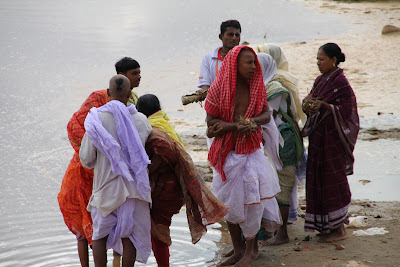I saw magic today. Or in other words, I was doused in the history, traditions, and divine energy of some of the eastern world’s richest and most significant holy sites. Bihar presents a fascinating juxtaposition of an unusual wealth of religious and cultural treasures amidst a disproportionately high rate of economic poverty. I was brought here for the fourth time this year through my work and am blessed to have taken part in rites and rituals of traditions whose followers aspire to but never get to experience in an entire lifetime.
With a pilot project being launched in Gaya district, I was taken back to Bodh Gaya, home to the Mahabodhi temple where one can find the bodhi tree under which Buddha attained enlightenment. We spent several days there, analyzing data that was collected from the households we hope to enhance the livelihoods of by building their skills and linking them to more sustainable labor opportunities. As we brainstormed possible interventions, products, and services and how these could be customized to meet the needs of the poorest, the one thing our team could agree on was that we couldn’t have, by chance, ended up selecting a more opportune and symbolic target area.
Before leaving Gaya this morning, I was finally able to visit one of the oldest temples of Hinduism- Vishnupadh- which means foot of Vishnu. The construction date of the original temple is unknown, and believers claim that once Vishnu set foot here, the temple sprouted from the ground overnight along the banks of the Falgu River. The temple itself has no mulasthanam or central shrine that typically houses the primary deity of a temple. Rather, Vishnu’s footprint, known as the Dharmasila, which has been incised in a block of basalt within a silver-plated basin, serves as the center of worship. Interestingly, it is also believed that Rama and Sita visited this temple to perform the last rites for King Dasharatha along the banks of the Falgu river. To this day, every year, specifically during this week, Hindus from all over the world make the pilgrimage to Vishnupad to perform the last rites for their deceased parents (Pin-Daan).

Adhimoolam of the Vishnupad temple

Family performing pindaan in the temple

Many families performing pin daan on the banks of the Falgu river

Another family performing pin daan for their forefathers
 Sri Vishnu statue in a smaller temple at Vishnupad
Sri Vishnu statue in a smaller temple at Vishnupad
 One of many merchants selling items for use in pujas or to be blessed to take home
One of many merchants selling items for use in pujas or to be blessed to take home
My day was not over yet. After making the 4 hour drive back to Patna, I figured I’d make the best use of my last evening in town and visit one of Sikhism’s five most significant sites or takhts- the Sri Darbar Sahib Patna Sahib. The journey took about one hour, as the site is located in one of Patna’s oldest quarters, previously known as Kucha Farrukh Khan, but now more commonly known as Harmandir Gali. After driving through a series of narrow lanes crowded by local vegetable markets, rickshaws, autos, cyclists, and pedestrians (so we were the only ones in an actual car), we finally reached the gates to Patna Sahib.
The enormous, white marble gurudhwara here was constructed to honor the birthplace of Guru Gobind Singh, the tenth guru of the Sikhs. Until we passed through the gates, I would have never guessed that there could be anything of significance in this bustling but secluded town that could attract so many from far and wide. Once inside the premises, it was an entirely different world. Sikhs from all parts of the world had gathered in masses to engage in worship. The bhajans from inside the gurudhwara flowed throughout the grounds of Patna Sahib. I entered the gurudhwara after removing my shoes and washing my feet in the common basin for all worshippers. Though I’ve visited a few gurudhwaras before, this was an entirely unique and awe-inspiring experience for me as I observed worshippers streaming in one by one, many with their kirpans (sword or dagger) strapped around their waste, bowing down before the holy book before being seated, women and men on separate sides of the room.
 Patna Sahib Gurudhwara
Patna Sahib Gurudhwara Pilgrims making their way around the mandir
Pilgrims making their way around the mandir
As I approached the white marble gates of the gurudhwara, azaan or the call to prayer from neighboring mosques rung through the air as the sun began to set. I gazed upward into the sky, which by that point was strewn with hues of blue, purple, and pink, and felt the magic that makes India the divine and timeless masterpiece that it is.

No comments:
Post a Comment